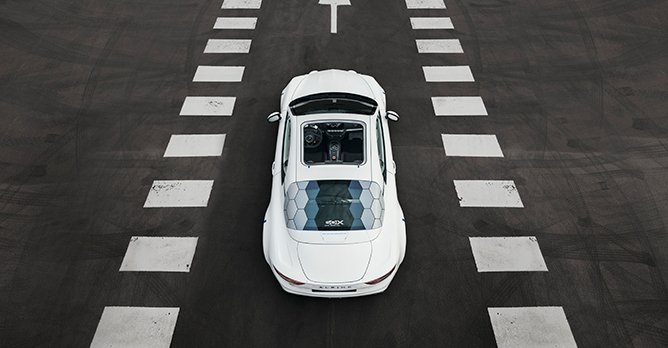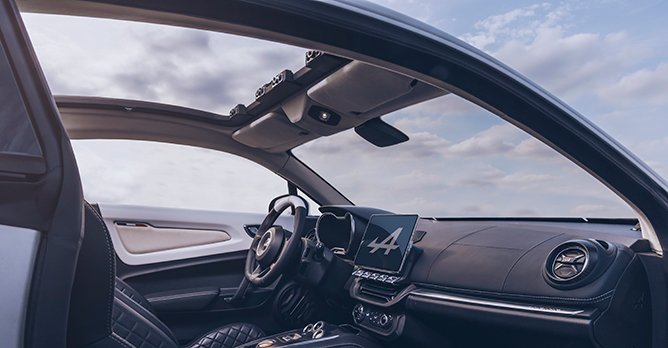Alpine reveals all-electric A110 E-ternite concept
24 Jul 2022|926 views
Alpine has launched its Alpine A110 E-ternite prototype car in France, a rolling laboratory which aims to be the lightest open-top electric sports car in its segment.
This emphasis on being the lightest was in order to not compromise on performance, balance and agility of the standard Alpine A110 with a combustion engine.
Four innovations were added to the prototype to create an even bigger engineering challenge namely: Amultimedia system using the driver's personal tablet for a more intuitive connectivity experience, a highly advanced audio system with eight speakers to create a surround sound effect, the use of innovative materials to combine performance and sustainability, and a 'top off' solution that allows the driver to enjoy the quietness of the purely electric drivetrain.
Other challenges were also faced during the development of the electric Alpine.
This included the need for a bespoke gearbox. Alpine's engineers were unable to find an in-house gearbox that was sufficiently smooth and efficient to suit the nature of the car. Therefore, a gearbox was studied in house with the Alpine gearbox supplier in double-clutch form with an electronic control.

 Alpine A110 E-ternite is a sign that Alpine might release a fully electric production version of the Alpine A110 sometime in the future This double-clutch solution made it possible to avoid a break in torque while remaining compact and light.
Alpine A110 E-ternite is a sign that Alpine might release a fully electric production version of the Alpine A110 sometime in the future This double-clutch solution made it possible to avoid a break in torque while remaining compact and light.
Another challenge faced was in achieving an optimum weight distribution for the batteries and accommodating twelve battery modules. What engineers did was to design specific battery casings for the A110, adapting to the internal architecture.
This meant four modules places at the front and eight at the rear. Despite the addition of these twelve modules, Alpine managed to add only 258kg to the car's weight which is a considerable feat in electrifying the Alpine A110.
This emphasis on being the lightest was in order to not compromise on performance, balance and agility of the standard Alpine A110 with a combustion engine.
Four innovations were added to the prototype to create an even bigger engineering challenge namely: Amultimedia system using the driver's personal tablet for a more intuitive connectivity experience, a highly advanced audio system with eight speakers to create a surround sound effect, the use of innovative materials to combine performance and sustainability, and a 'top off' solution that allows the driver to enjoy the quietness of the purely electric drivetrain.
Other challenges were also faced during the development of the electric Alpine.
This included the need for a bespoke gearbox. Alpine's engineers were unable to find an in-house gearbox that was sufficiently smooth and efficient to suit the nature of the car. Therefore, a gearbox was studied in house with the Alpine gearbox supplier in double-clutch form with an electronic control.

Another challenge faced was in achieving an optimum weight distribution for the batteries and accommodating twelve battery modules. What engineers did was to design specific battery casings for the A110, adapting to the internal architecture.
This meant four modules places at the front and eight at the rear. Despite the addition of these twelve modules, Alpine managed to add only 258kg to the car's weight which is a considerable feat in electrifying the Alpine A110.
Alpine has launched its Alpine A110 E-ternite prototype car in France, a rolling laboratory which aims to be the lightest open-top electric sports car in its segment.
This emphasis on being the lightest was in order to not compromise on performance, balance and agility of the standard Alpine A110 with a combustion engine.
Four innovations were added to the prototype to create an even bigger engineering challenge namely: Amultimedia system using the driver's personal tablet for a more intuitive connectivity experience, a highly advanced audio system with eight speakers to create a surround sound effect, the use of innovative materials to combine performance and sustainability, and a 'top off' solution that allows the driver to enjoy the quietness of the purely electric drivetrain.
Other challenges were also faced during the development of the electric Alpine.
This included the need for a bespoke gearbox. Alpine's engineers were unable to find an in-house gearbox that was sufficiently smooth and efficient to suit the nature of the car. Therefore, a gearbox was studied in house with the Alpine gearbox supplier in double-clutch form with an electronic control.

 Alpine A110 E-ternite is a sign that Alpine might release a fully electric production version of the Alpine A110 sometime in the future This double-clutch solution made it possible to avoid a break in torque while remaining compact and light.
Alpine A110 E-ternite is a sign that Alpine might release a fully electric production version of the Alpine A110 sometime in the future This double-clutch solution made it possible to avoid a break in torque while remaining compact and light.
Another challenge faced was in achieving an optimum weight distribution for the batteries and accommodating twelve battery modules. What engineers did was to design specific battery casings for the A110, adapting to the internal architecture.
This meant four modules places at the front and eight at the rear. Despite the addition of these twelve modules, Alpine managed to add only 258kg to the car's weight which is a considerable feat in electrifying the Alpine A110.
This emphasis on being the lightest was in order to not compromise on performance, balance and agility of the standard Alpine A110 with a combustion engine.
Four innovations were added to the prototype to create an even bigger engineering challenge namely: Amultimedia system using the driver's personal tablet for a more intuitive connectivity experience, a highly advanced audio system with eight speakers to create a surround sound effect, the use of innovative materials to combine performance and sustainability, and a 'top off' solution that allows the driver to enjoy the quietness of the purely electric drivetrain.
Other challenges were also faced during the development of the electric Alpine.
This included the need for a bespoke gearbox. Alpine's engineers were unable to find an in-house gearbox that was sufficiently smooth and efficient to suit the nature of the car. Therefore, a gearbox was studied in house with the Alpine gearbox supplier in double-clutch form with an electronic control.

Another challenge faced was in achieving an optimum weight distribution for the batteries and accommodating twelve battery modules. What engineers did was to design specific battery casings for the A110, adapting to the internal architecture.
This meant four modules places at the front and eight at the rear. Despite the addition of these twelve modules, Alpine managed to add only 258kg to the car's weight which is a considerable feat in electrifying the Alpine A110.
Latest COE Prices
November 2025 | 1st BIDDING
NEXT TENDER: 19 Nov 2025
CAT A$110,002
CAT B$115,001
CAT C$76,000
CAT E$121,010
View Full Results Thank You For Your Subscription.

























